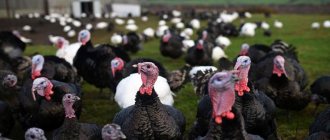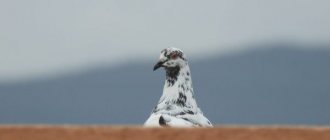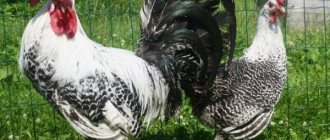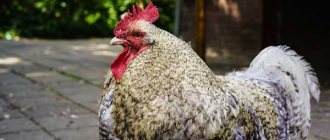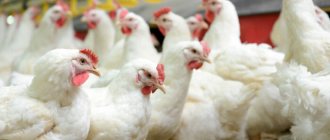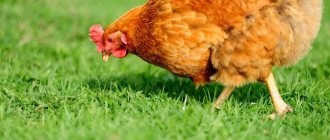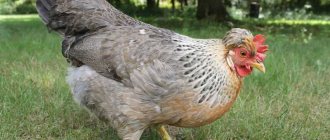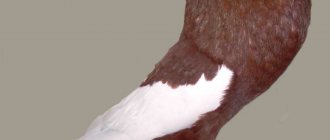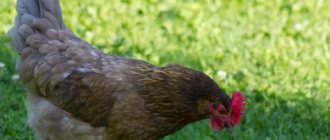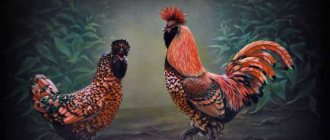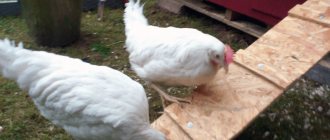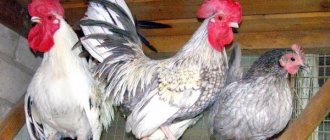Poultry farming » Pigeons
0
1493
Article rating
Kira Stoletova
Until recently, Kingi pigeons, used only in cooking, today decorate bird shows and fairs. This breed was bred from the parent Vikings and Postal, and to this day it has not lost its popularity among poultry farmers.
Description of King pigeons
Much has been written and debated about the benefits of pigeon meat and the peculiarities of raising the King breed. This species of birds has caused a stir among farmers and owners of large farms.
Maintenance and breeding
It is not difficult to keep King pigeons; they are unpretentious in living conditions and food.
Birds independently hatch eggs and take care of future offspring. This applies to meat breeds; with show breeds it is a little more difficult. Pigeons should make nests on the floor or a small hill, taking into account that the nest can be reached by a perch. This order is necessary due to the large weight of the bird, which does not allow it to take off.
Pigeons can be kept both in cages and in enclosures with possible walking. Doves aged 1-2 years have good egg production.
Pigeons that have reached 6-8 months are completely ready for mating. 10-15 days after mating, the female lays eggs. After a week, during the incubation period, it is necessary to very carefully check the eggs to see if the embryo is developing inside. An egg that remains transparent for a long period is unfertilized.
A dove can lay 2 eggs per clutch. With good lighting in winter, a dove can make 5-6 clutches, otherwise only 3. Over the entire period of keeping, one pair can produce up to 20 chicks.
At an early age, chicks feed on “crop milk”. Already from the 6th week of life they can eat food on their own. 4 months after birth they weigh up to 600 g.
Nowadays, in order to increase the production of pigeon meat, king pigeons began to be crossed with racing pigeons. The offspring are distinguished by increased weight and fertility from their parents.
The bird's diet should include: barley, corn, groats, millet, coarse oats, etc. Mineral supplements and vitamins must be added to the food.
How to properly keep and care for birds
Pigeons of the breed are not too demanding on conditions and can be raised in a spacious poultry house. But it is advisable, for better health and weight gain, to provide a covered walking area next to the poultry house. Inside the dovecote you need to install a ventilation system, heating, and lighting if necessary. Kings, due to their heavy weight, are reluctant to fly, but behave calmly when walking.
See also
What external signs distinguish a pigeon from a dove, how to determine the genderRead
Pigeons are fed grain and legume mixtures, into which you can put any grain; large ones, such as peas and corn, need to be chopped. Fresh herbs, some grated vegetables, and feed additives are added to the grain. Minerals and vitamins have a beneficial effect on the development of the bird's body, the maturation of young animals and future fertility, and prevent and protect against diseases.
An adult bird can eat 50-65 g of grain per day. This amount should be divided equally and given to pigeons 2 times a day. You cannot feed spoiled, sour, and especially moldy food. Water in drinking bowls should be poured around the clock. It needs to be changed every day. In winter, heat it up if the room is cold.
Expert opinion
Zarechny Maxim Valerievich
Agronomist with 12 years of experience. Our best country expert.
Ask a Question
Kings are considered aggressive, so it is not advisable to keep them together with pigeons of other breeds. They suppress them with their mass. As a last resort, you can add small breed chickens to the pigeons
.
Wood Pigeon
This wild pigeon is larger than its relatives. Its weight exceeds 90 grams, body length is 40 cm.
In the habitats of the wood pigeon, you can hear its inviting cooing in the morning.
When taking off, the wings emit a characteristic whistle - this is not typical of all breeds.
The color is gray-blue, with a reddish tint on the chest. There are white spots in the neck area.
Each wing has a white marking, visible only during flight.
It is wary of people, hiding from them in dense thickets.
It is especially hidden during the breeding season. The habitat extends from the African continent to Russian latitudes.
It is a migratory bird and forages for food in the fields.
Many hunters choose the wood pigeon as prey, which affects the number of birds of this breed.
Requirements for a dovecote
Most pigeon breeders build such a room themselves, trying to adhere to the minimum sanitary requirements for housing birds:
- For safety reasons and to prevent small rodents and predators from entering the dovecote from the outside, the dovecote is sheathed with sheet iron or an outer box made of sheet iron 1.5-2 mm thick is welded. Such a box allows you to avoid the formation of cracks and drafts.
- The dovecote can be made of a frame made of wooden beams with a cross-section of 50x100 or 50x150 mm, covered with sheets of flat slate. In this case, it may be necessary to foam the joints of the sheets and externally seal the joints with water-repellent compounds.
- Any dovecote must have supply and exhaust ventilation. An increased concentration of ammonia released from the droppings will lead to the bird becoming sick with dropsy.
- Keeping pigeons requires a temperature in the dovecote ranging from +10 °C to +25 °C, so the walls of the room must be insulated from the inside. It would be undesirable to insulate with mineral wool slabs, which will release phenol and tiny fibers into the air that enter the bird’s lungs. It is best to insulate a dovecote with ecowool, blowing it between the outer wall and the inner wall made of clapboard on a wooden sheathing.
- Floors must be insulated and have a hard surface. This will allow for sanitation in case the bird becomes sick. For insulation, polystyrene concrete with a cement-sand screed on top is suitable.
- Lighting. Pigeons develop normally when exposed to light for at least 12 hours, so lighting will be necessary in winter. It can be arranged using low-power LED lamps.
- Heating. Insulated walls will help you avoid sudden changes in temperature, but will not save you from getting cold during the cold season. The dovecote requires heating that does not burn the oxygen in the room. These can be electric infrared lamps or panels.
- Sections for hatching chicks. They are arranged in the form of racks, separated by partitions, along long side walls.
- Keeping young animals. An adult bird can drive the young out of the most convenient places in the dovecote, so it is necessary to place one individual perch for each pigeon on the internal walls or racks.
Inventory
The following equipment is used in the dovecote:
- Individual perches. Every young pigeon or adult pigeon needs a perch. It is made from two wooden planks 10 cm wide, knocked together into a house and nailed to a wall or frame post with the top up. The design of the perch allows them to be placed on top of each other to save space.
- Feeder. Do not scatter food for feeding pigeons on the floor. The room should have a feeder with windows, the number of which is equal to or greater than the number of birds. The top of the feeder should be closed to prevent droppings from entering. The volume of the feeder must correspond to the feeding norm - 50 g of grain per head.
- Nests for hatching chicks. They are made in the form of shelves with partitions along the walls or in the form of an open adjustable bookcase standing against the wall. In each resulting compartment, a box made of wooden planks without a bottom is placed to organize a nest.
- Drinking bowl. It is better to use special plastic drinkers made from a container turned upside down and a round plate with a recess for water. The drinking bowl should be in a place inaccessible to contamination by droppings.
- Bathhouse. The easiest way is to put a small plastic basin with a small amount of water, which needs to be changed daily.
- Dishes for minerals. A metal or plastic bowl will do. You can use an additional feeder, pouring chalk, small stones, and crushed shell rock into it.
Security requirements
Important:
- It is prohibited to place dovecotes near power lines.
- A high pole for determining wind direction and a perch for resting after flights must be grounded.
- If the outer surface of the dovecote is metal, it must be grounded.
- Indoors, you cannot use powerful lamps for lighting and powerful heat sources with a small cross-section of the electrical supply cable.
- All wall or ceiling infrared heaters must have a protective shield made of tin at the rear.
- The wiring in the dovecote must be placed in a metal sleeve.
Main features of Uzbek fighting pigeons
In terms of appearance, Uzbek pigeons are distinguished by the greatest diversity. This applies to both the shape of the plumage and colors. And the body shape varies in places. Depending on the variety, fighting pigeons may vary in neck length, beak size, and body weight. The forelock and braids may also be present or absent. The forelock is the head plumage, which can also vary in shape, and the braids are additional feathers on the legs, they are sometimes called pants. In a number of breeds, these same hairs are considered a sign of purebredness. At the same time, there are several standards of Uzbek fighting pigeons that breeders are guided by.
These birds are called fighting because of the sounds they make during flight, when they beat their wings in a special way and somersault. Birds of this species are also capable of flying vertically upward and performing other interesting tricks. Moreover, the age at which a bird begins to beat its wings and fly in this manner varies greatly. Depending on the variety, she can begin to perform similar tricks either at the age of 2-3 months or in the second or third year of life. Even among birds of the same species, this period varies individually for its different representatives. But Uzbek pigeons are not distinguished by this characteristic.
There are several ways to divide these poultry. Some pigeon breeders distinguish them by their flight qualities. Others prefer to look at size and exterior. It all depends on the specific breeder, but there are three main methods by which professionals distinguish these birds. By the same principle, Uzbek pigeons are distinguished according to the standard accepted in the world. These are the options:
- Division of Uzbek fighting pigeons into flying and exhibition birds.
- The division of these birds into different breeds. For example, Molokans, gulbadams, traps, chinns or chelkars.
- Division according to external characteristics: the presence and shape of the forelock, the presence of hair, color and length of the beak.
Are you here
Why are pigeons and meat ones at that? Step No. 1 I always wanted to keep some kind of livestock at the dacha, fortunately there are more than enough premises on a rural estate. But there is one very serious problem: I don’t go there every day. I went through a bunch of materials about animals and birds, and decided to deal with birds, since animals require human presence every day (except for rabbits). But rabbits are uncomfortable with the danger of a sudden epidemic. As we studied the material on poultry, everything turned out to be not as rosy as it seemed at first: Some need walks, others need expensive automation, others need heating, etc. and so on. Incubators, brooders, it turns out that you need to give up everything and deal only with birds, or not deal with them at all and not torment yourself or your pets. On one of the forums I read a conversation about meat pigeons, and the idea of pigeons stuck firmly in my head. If you do poultry in your free time, then do it with meat pigeons. There are a huge number of advantages compared to the disadvantages. 1. There are practically no competitors in the market. As we collected information about the breeds of meat pigeons, basically all the information boiled down to one phrase - “where to get meat pigeons.” 2. Higher price per bird compared to the cost of rearing. For example, a hunting pheasant costs about $15, a pair costs $30; the simplest industrial lines of king - $50 (pair), Polish lynx - $30 (pair). And if you count the costs of raising pigeons and pheasants, the difference is huge. 3. The bird is very resistant to diseases (if properly kept). 4. Does not require heating. 5. Does not require daily presence. 6. Automatic feeders and automatic waterers are cheap. 7. Reproduces in the presence of light all year round, except for molting. Any cheap mechanical daily timer can turn on the backlight in winter. 8. Pigeons are excellent at hatching their chicks. No incubators needed. 9. They are also excellent at raising their young without human intervention. Heated brooders are just an extra detail. 10. They don't need animal proteins like chickens. 11. Exceptional taste and dietary properties of meat. Frankly speaking, there are not many disadvantages: 1. These are monogamous, for each female a male is required. 2. A small number of offspring per year, on average 12-18 chicks. 3. Not a large carcass weight. 4. Not everyone can accept pigeon meat as food. Well, the cons are actually quite controversial. The first fact is obvious, nothing can be done. You may not agree with the second, because a hen will raise barely more chickens per season. Well, regarding the weight of the carcass, there are also smaller birds, the same quail. The fourth is more difficult, due to historically established prejudices. But there are a huge number of lovers who want to buy not meat, but live poultry. After all, selling birds is much more profitable than selling meat. Well, if there are unclaimed chicks left, there will be a connoisseur. And you can grill it yourself and surprise your friends. Step #2. Soon after the decision to have pigeons, the opportunity arose to purchase four King chicks of the industrial line (the parents were transported from Hungary). Within a few days the Kings were in my barn. Because I haven't decided on the content system yet. They were simply released onto the floor of the room. I installed a vacuum drinker and the same feeder, fine gravel, and chalk. That's all the preparations. A couple of photos of my first pigeons:
What do King pigeons look like?
Currently, Kings have found their use not only as meat birds, but also as an exhibition breed. What does the King pigeon look like: photo.
Breed representatives boast a massive size of 700-800 grams. Birds taking part in exhibitions gain weight up to 1.5 kg. Kings have thin skeletal bones, and pigeons with white feathers are predominantly found. Wings with a small span.
Let's take a closer look at the appearance characteristics:
- the thoracic region is rounded and well developed;
- the eyes are small, in pigeons with dark colored feathers they are amber, in white pigeons they are dark;
- have a powerful beak;
- the wings are small and rather short;
- the limbs are distinguished by a strong structure, there is no feather cover;
- tail feathers are short;
- the dorsal region is wide.
As mentioned earlier, birds are very poorly adapted for flight, and they also have an aggressive nature. There are kings with silver and brown feather colors.
French Mondain pigeons
The French pigeon Monden is one of the best modern meat breeds. It is a large bird with an impressive, well-rounded, wide and deep body. The head is small, round with a short massive beak. The neck is short, full, powerful. The chest is expressive, full, protruding with the wheel forward. The wings are rounded, pressed to the body, the tail is narrow and short.
Males of Mondena weigh from 0.9-1.3 kg, females are lighter and weigh 0.85-1.2 kg. Young animals in the productive period of one month of age (squabs) reach an average weight of 450-500 g. These are excellent weight indicators in pigeon breeding, in addition, the breed has an excellent yield, the carcasses are round, the meat is tasty, tender, juicy.
The colors of Mondens are varied, the most common are black, gray, silver, yellow, ash, ash red.
About the breed
The very first mention of King pigeons appeared in 1890. The USA (California) is considered their homeland. The development of this breed is the result of long experiments and natural breeding of different types of pigeons. As a result, after crossing several breeds: postal, Maltese and Roman, breeders received a new species, which was named King.
These birds are a fleshy, thin-skinned breed that has long been widely recognized far beyond the borders of the United States, incl. in Ukraine and Russia.
Even to a lay observer, the photo of the chicken and King will seem similar. Which is not surprising, since the Kings are a chicken-like group of pigeons. They gain an impressive mass for these birds - about 1000 g.
However, the purpose of their breeding is not only for industrial interest; Kings are also kept for demonstration at exhibitions. They are usually more presentable and beautiful.
Origin
The King breed itself was developed in the USA at the turn of the 19th and 20th centuries. The first breeders sought to create a breed that would have the following properties:
- It was capable of carrying letters, like carrier pigeons.
- It was meaty enough and quickly gaining weight to satisfy the needs of pigeon lovers.
As a result, the first kings were noted in breeding books in the 1890s. In 1921, breeders created the first standard for this pigeon breed in order to agree on future selection paths.
Fighting pigeons
They got their name from the unique clapping noises they make during flight. Fighting pigeons have rather narrow wings; the pigeon must make more effort to fly. Narrow wings reduce air resistance; during flight they touch each other with a loud and dull bang. The main feature of pigeons is not the clap in the air; these celestial creatures tumble while flying.
The reason for the somersaults was the powerful and well-developed tail feathers. After a short flight, due to weak wings and a powerful tail, the birds begin to descend strongly; in order to level out the “roll”, the pigeons need to do a somersault so as not to crash on the ground.
Interesting fact! Aerial somersaults cause severe disorientation in the air. And if the bird does not complete a full rotation around “its axis,” it will simply crash to the ground at full speed. Therefore, many pigeon breeders reject slaughter animals that are not able to turn over 360 degrees in the air. Birds' tail feathers are often trimmed to reduce the risk of injury or death.
The group of fighting pigeons includes several breeds that have their own interior and feather color.
Business registration form
There are several types.
Private household plots
A novice businessman can raise pigeons “for meat” as part of organizing a personal subsidiary plot. In accordance with this, income from the sale of meat raised in private household plots is not taxed. However, three conditions must be met:
- The area of the plot does not exceed 50 acres.
- There are no hired workers.
- The local tax authority must be provided with a certificate from the local government stating that the meat produced was grown and processed (frozen) in private household plots.
The owner of a private household plot does not pay insurance premiums, therefore, he does not have length of service and does not receive a pension.
peasant farm
To sell their products to third-party organizations (shops, restaurants), they need a different legal form - a peasant farm (peasant farm) with a seal for concluding supply contracts and a bank account.
Here, it is best to open a peasant farm using a simplified taxation system with the form “income minus expenses.” There is a minimum of reporting, and the amount of taxes will be 15% of net income exceeding 300 thousand rubles per year.
In addition to taxes, you need to pay mandatory insurance premiums “for yourself”, and if you have employees, insurance premiums for each of them to accrue pension service and payments for health insurance in case of illness.
IP
The pigeon does not belong to the agricultural poultry, and in the codes of the All-Russian Classifier of Types of Economic Activities (OKVED) it has code 01.49 “Breeding of other animals”, therefore it will be permissible to open a business in the form of individual entrepreneurship on the same conditions as peasant farms.
OOO
You can engage in this type of activity by opening an LLC. But in this case, the business must generate greater profits and be profitable in order to cover the costs of taxes and social insurance for employees.
Large meat breed with rapid weight gain King
A proud bird with a difficult character Dragon
Birds capable of rising into the sky to great heights Nikolaevskie
Ability for acrobatic somersaults and spectacular flights Thurmany
An ancient beautiful breed native to India Peacocks
Decorative breed with an abundance of decorations and good flight ability Chinese gull
A breed group of elegant birds with a calm, confident behavior
Burning rays of sun in my dovecote. Features of the domestic Krasnodar breed
A breed of pigeons with the exceptional shine and beauty of Bullfinch feathers
Good-tempered, low-flying phlegmatic creatures with an unusual appearance
Four types of breed. Flight characteristics and appearance features of the Kursk
Fighting pigeons, characterized by flapping wings and acrobatic flight at high altitude Kasana
Decorative breeds of pigeons
They are divorced solely for the sake of beautiful appearance. Birds may differ in posture - for example, stately breeds have a strongly protruding chest, unusual color, and shape of plumage. Sometimes various decorative pigeons are very reminiscent of winged relatives of other species - owl, seagull, swallow - and receive corresponding nicknames.
peacock pigeon
The most famous representative of the decorative trend. The name is given by the main external feature - a fluffy tail, the feathers of which are spread out to the sides.
The first mention of these beauties dates back to the 16th century; distant India became their homeland. Since then, the breed standard has changed somewhat.
Today, great importance is attached not only to the tail, but also to the characteristic posture. The description of the standard is very lengthy and contains many details. But the main characteristic of the breed remains the shape of the body - it can fit into a ball when viewed from the side.
The chest is strongly raised up, arched, and the line of the back is concave inward. The tail should not have any distance between the feathers and should be positioned vertically in relation to the body. The standard even takes into account the number of feathers - their number ranges from 32 to 50.
Pouters
It's every fan's dream to launch a flock into the sky. All because of the bright appearance, which arose due to the enlarged goiter area.
The homeland of these gentle creatures is Europe. The most popular varieties are from England and the Czech Republic.
Pouters should be kept separately from other pigeons in order to maintain the purity of the breed and selection should be carried out.
The bird requires careful care, unlike its outbred counterparts. Each breed has its own standards. But there are also common features:
- Vertical position of the body.
- The body is large, the head is small with a round forehead.
- Puffers are capable of strongly inflating the chest, which protrudes majestically forward.
- Long wings, feathered legs.
With such a spectacular appearance, the blowers fly rather poorly.
Basic cultivation methods
You can raise meat pigeons by following one of 3 methods, which are selected depending on:
- planned number of birds;
- the purposes of their cultivation;
- climatic conditions of the region;
- the breeder's own capabilities.
Intensive method
It involves intensive fattening of birds for slaughter kept in dark rooms. It takes about 2 weeks to fatten.
Force feeding is carried out up to 4 times a day using a syringe with a soft rubber nozzle. For fattening, a porridge-like mixture is used, which is produced from products containing large quantities of proteins (cereals, legumes) and mineral complexes. One individual needs 60 g of porridge per day. After feeding, the birds must be offered warm (+30°C) clean water.
The disadvantage of this method is the risk of developing various diseases in birds living in cramped conditions. The meat of this bird is high in fat.
Extensive method
It is the least expensive in terms of fattening. Suitable for breeders living in favorable regions with extensive green plantations at their disposal. With this method of rearing, the bird provides itself with food throughout the entire warm period, and the breeder supplements it with cereals once a day. This method is closest to the natural habitat of pigeons. The meat of pigeons, which have the ability to move freely, has a higher nutritional value.
Did you know? In the Middle Ages, carrier pigeons were valued as highly as thoroughbred breeding stallions.
The downside is the need to provide an area with a self-replenishing supply of food, which is problematic to do. In addition, well-fed pigeons of meat breeds can become easy prey even for domestic cats, not to mention predators. In addition to the problems listed above, there is a risk of the bird becoming infected with diseases and parasites through contact with other inhabitants of the yard.
Combined method
The combined method of raising meat pigeons is something between intensive and extensive. Most suitable if the purpose of poultry breeding is to make a profit.
Texan pigeons
These are precisely the animals that were able to incorporate first-class meat qualities and a decorative exterior, forcing pigeon breeders to breed these birds. They have completely white, light brown or brown and white colors that are not found in any other breed.
The birds have perfectly adapted to living next to people, and therefore feel great both in the wild and in an aviary. They don't particularly like to fly, but a sedentary lifestyle will cause Texans to become overgrown with fat, which should not be allowed.
The birds have a broad chest and a medium-sized neck. The legs are pink, sometimes red, underdeveloped. Texans have average flight performance and low endurance, but all these disadvantages are covered by the weight of the bird.
These pigeons are second in weight only to the Roman giants.
External features
This breed was bred at the beginning of the last century by breeders from the USA based on three breeds: Romans, Maltese and Postal. It is bred not only for meat, but also as an ornamental bird.
Its distinctive features are:
- color - white is dominant, silver, red and black are less common;
- the head is relatively large, the beak is strong, of medium size, the eyes are yellow or black;
- neck - short, thick;
- the body is massive, short and wide;
- chest - very wide, convex, rounded;
- tail - short, raised up;
- lower limbs are of medium length, strong, without feathers;
- the wings are short, noticeably widening in front, the bird flies with difficulty;
- behavior is active, males can show aggression towards each other.
Development of pigeon farming
Pigeon breeding is not a means of making money. Most often, amateurs do this in their free time. If you get seriously involved in the process, you can supply dietary meat for sale. With intensive fattening, young chicks gain up to 700–800 g in a month or a month and a half. After the carcass of such a pigeon is plucked and gutted, its weight can be 400–450 g. But a similar result can be obtained from certain meat pigeon breeds.
Meat pigeons
Meat breeds of pigeons were raised on the Mediterranean coast. In Greece, Ancient Rome and Egypt, the meat of these birds was included in the diet of different strata of society. But in Europe and the United States, they began to breed pigeons “for meat” only at the beginning of the last century.
Their meat was considered a delicacy. In some countries, work has begun to improve the quality of pigeon meat. And in the United States, some farmers bred tens of thousands of meat pigeon breeds on their farms, and this direction began to generate income. And subsequently, the breeding of meat pigeon breeds began in many European countries: France, Italy, Hungary, Germany and some others.
recommended articles:
- Pigeons are fidgety and dangerous to humans
- Takla: Turkish fighting pigeons
On farms where meat varieties of pigeons with a high propensity to reproduce are bred, one pair of birds per year can produce up to 13–17 chicks. Spending about 6 kg of feed on feeding them, after 30 days the breeders receive up to 1.5 kg of delicious dietary meat. Moreover, these types of pigeons are early maturing: after six months, the chicks already become sexually mature and are capable of producing offspring themselves. In general, from one pair of pigeons, with proper feeding and care, you can get 8–9 kg of meat per year.
King meat pigeons
In the process of raising these types of pigeons, the main emphasis is on the birds’ high digestibility of feed, undemanding maintenance, calm disposition, and the quality of feathers, which are also sold.
Productive qualities
To obtain an average weight of up to 800 grams, the birds are fattened for 45 days; for exhibition specimens the weight reaches one and a half kilograms. From one female king in 356 days you can get from 13 to 17 pigeons, which are distinguished by their fatness and meatiness. The yield of slaughter weight is on average 59-67%, depending on the growing conditions. Birds are kept in aviary or limited range methods.
King pigeon
Poultry farmers who decide to breed King pigeons using the cage method should know that in a month the pigeon will gain less weight than its brothers. A carcass without giblets weighs about 368 g, and the slaughter yield is no more than 55%. No matter how the Kings were kept, all representatives of this breed will have a meat yield of 50%, fat 16%, edible organs 5%. Everything else is not used as food and must be thrown away.
The most popular breeds
In our country, breeds of meat pigeons are not as widespread as abroad. In total there are about 60 species of birds. Conventionally, they are divided into three groups:
- Chicken;
- Gigantic;
- Meat.
Breeding meat species is becoming more widespread every year.
King
The King breed of meat pigeons was first bred in 1890 in America. This was done after quite a long selection process. The distinctive feature of this meat breed from others lies in the structural features of the individual’s body.
Males have long and widely spaced legs, a broad back and a medium-length tail. Externally, the birds are similar to other domestic chickens, since this type is a chicken-like species.
The plumage can be varied; individuals are most often grown in black, beige or red. Among individuals of this species, white males and females are of particular value.
The largest weight in males is 900 grams. Females weigh slightly less, averaging 600 grams. With a special diet, males can be fattened up to one kilogram. Representatives of this breed are considered conscientious parents. They hatch and raise their offspring themselves. With good feeding, pigeons at the age of 1 month will weigh 600 - 700 grams.
Hungarian giant
Giants first became widespread in Hungary and Turkey.
The main feature of this species is the birds' short legs, covered with dense plumage. Giants have a massive back, a small tail, and a wide chest.
Females can gain weight up to 900 grams, and males almost 1.2 kilograms. The annual litter of individuals is about ten chicks. The color can be of various colors. The most common birds are black, white, yellow and even blue.
Texans
Texan pigeons were developed in the 1950s in Texas. Individuals are highly fertile. The average weight of pigeons is 900 grams. Unlike other representatives, individuals have well-developed secondary characters. Therefore, determining the sex of hatched chicks is not difficult. Males have little fluff and a small lightish beak, while females have a clearly visible dark spot on their beak. The female's body is covered with long yellowish down.
When breeding a species, it is necessary to take into account and maintain special conditions. Adults also differ in feather color. Males have white feathers; the chest and neck may be yellowish or brown. Females have dark wings and a blue or grayish chest.
The main advantage of the species is the rapid growth of young animals, the breed's fertility and survival rate.
Every year they give birth to about 16 chicks. Pigeons have a calm character and feed well.
Texan pigeon
Modena
The birds are named after a city in Italy called Modena. It was there that they were first bred. Meat breeds of pigeons have many plumage colors. Modena individuals have approximately 200 different shades and feather patterns. The most popular breeds of meat pigeons from Madena include:
- German;
- English variety of Shitty pigeons.
These are the best Madena breeds. The English subspecies of birds has a large, massive shape. Pigeons are covered with plain feathers with small patches on the wings and head. Individuals have well-fitting plumage.
Modena pigeons
Carnot
The Carnot meat breed appeared thanks to the work of French breeders during the period of active introduction of mechanization processes.
Pigeons live and grow in an aviary, as they do not have the ability to forage.
The weight of the birds is small, the average weight is 600 - 700 grams. Birds are highly fertile and occupy first places in terms of productivity. Carnots are not decorative specimens. They have a small head and a thick neck. The bird's beak is pinkish with a curved end, short wings are undeveloped, so the bird should be kept in fenced enclosures. The most common are yellow, black and white plumage colors. The legs are thin without feathers.
Carnot pigeon
Strasser
Strasser is the best meat type of pigeon, the main advantages of which are:
- Excellent meat quality;
- Rapid growth;
- Decorative;
- High fertility.
Strasser meat pigeons hatch about 7 chicks per year. They have a well-defined wide chest, a long neck and short bare legs. The wingspan is average. The lower part of the body is white, and the upper part is darker. Strasser can be fed up to 800 g, females up to 600 g.
Individuals are very shy and often fight among themselves. Due to poorly developed wings, they fly poorly.
What to feed
For feeding king pigeons, cereals and legumes are mainly used, most often in the form of mixtures. This could be wheat, peas, corn, barley, oats, etc. Here is a well-proven feed mixture:
- millet - 30%;
- wheat - 20%;
- barley - 20%;
- peas - 15%;
- corn - 15%.
During the period of active growth of young animals, it is recommended to add a little fish oil, salt, as well as chalk or shell rock to this mixture.
For birds of any age, it is advisable to add succulent green food at the rate of 10 g per day per pigeon; in winter, the greens are replaced with hay or grass meal. In addition, boiled potatoes can be mixed into the food. When feeding, vitamin supplements are usually used (“Chiktonik”, “Trivit”, etc.): during the breeding period, for the prevention of vitamin deficiency, during the growth of young animals. They are used according to the instructions.
General impression
Large pigeons, stately, densely built. The plumage fits well to the body. The feathers are smooth and do not bristle.
Appearance – somewhat overfed and too fat pigeons. Kings really lack elegance, but they compensate for this with their seriousness and charisma: this is not a dove, but a dove that you want to address by name and patronymic.
StandardFeaturesMeat productivity
According to the standard, a king pigeon must meet the following requirements:
- The head is large and smooth. The eyes are small, in individuals with dark plumage - amber, in white pigeons and doves - dark. There are usually thin red-purple lines around the eyes.
- The beak is powerful, well developed, there are no requirements for color or degree of development. The wax is tender, as if slightly powdered.
- The neck is of medium length, moderately developed. The wings are short and densely feathered. The tail is short, poorly developed.
- The back shape is wide.
- The legs are of medium length, there is no feather cover.
In general, the king pigeon's body structure is more similar to a broiler chicken than to a pigeon. The reason for this is the purpose: this is a meat weakly flying breed.
The character of the kings is lively, combative, and sometimes aggressive.
Vitality is high. The breed is not demanding regarding breeding conditions, so there are practically no problems with breeding.
Brood quality is high. Doves of this breed are excellent mothers, they hatch eggs well, and their egg production is plentiful. The only exception is exhibition specimens: their fertility is reduced.
The king pigeon breed has the following advantages:
- high egg production in pigeons under 3 years of age;
- fast growth. By 6-8 months, king pigeons are ready to mate;
- rapid weight gain;
- preservation of the meat qualities of the breed when crossed with other pigeons.
The disadvantages are as follows:
- doves often incubate unfertilized eggs;
- tendency to obesity. Because of this, when industrially breeding pigeons for meat, king pigeons are often crossed with carrier pigeons - large birds are obtained with a large amount of meat rather than fat.
King pigeons are a meat breed. Their meat has a delicate taste, moderate fat content, high volume (especially when crossing male kings with doves of sporting breeds), and moderate fibrousness.
King pigeons are usually slaughtered for meat at the age of 4 months, when the young animals gain weight of more than 600 g and combine good mass and tenderness of meat. You can wait and slaughter males weighing more than a kilogram - but their meat is tougher and more fibrous than that of young animals.
Kings, like other meat breeds, allow the slaughter of young animals at the age of 28-35 days. However, the specific time of slaughter depends on the growth of the particular bird, feeding conditions and other features of keeping the pigeon population. Here the poultry farmer faces two problems at the same time:
- do not overcook the meat, making the meat too fatty and tough;
- do not kill too early, without allowing the young pigeons to grow to optimal condition and gain the required weight.
Disease Prevention
Kings do not have diseases unique to them, for example, genetic ones. But, like other breeds of pigeons, they can develop viral and bacterial infections. Kings suffer from salmonellosis, coccidiosis, psittacosis, paratyphoid, trichomoniasis, and birds are affected by helminthic infestations.
Diseases spread quickly and the entire flock can become infected. You will need treatment, which is not cheap. Therefore, it is recommended to carry out preventive treatments of young and adult pigeons with antiparasitic and anti-infective drugs, and carry out routine vaccination. New birds purchased from other farms must first be quarantined for at least 2-3 weeks and only then sent to others.
You need to maintain immunity by proper feeding, cleaning the poultry house, aviary, and nests. Sterilize all equipment and premises 2 times a year or more often. In a clean dovecote, the likelihood of infection is always lower. Pigeons need to be let out for a walk; walking has a beneficial effect on the psyche and physical health.
The King breed is known to lovers as a meat breed and at the same time decorative. It is grown by both private owners and farmers. Keeping birds is not difficult; they require standard care and nutrition. Pigeons are fertile, grow quickly, and can be raised for meat for your own consumption or for sale.
Breeds of domestic pigeons
Nowadays, bird lovers are increasingly interested in meat types of pigeons, since they can be bred for a hobby and even for additional income.
The main meat breeds of pigeons with photos and characteristic features will be described below.
Peculiarities
When breeding poultry for slaughter, it is sent for meat as early as possible, because everyone knows that young animals have very tender, juicy and pleasant-tasting meat. Therefore, broilers are raised at home, which quickly gain weight.
Keeping and caring for representatives of meat breeds is aimed at fattening the bird faster, since slaughter is most often carried out 4 weeks after the chick hatches. At this age, carcasses are easier to clean from feathers, and their meat is very juicy and soft.
Description
Today there are a large number of meat breeds. They are divided into three groups: meat, chicken and gigantic. Each group includes several species of birds and is distinguished by certain characteristics.
Outwardly, they resemble ordinary domestic birds, but are larger in size. Representatives of this species are (Figure 1):
- The Moravian Strasser comes from Moravia. These birds have smooth plumage, a wide back, and average height. The main color of the plumage is snow-white, and the head, wings, tail and back are colored. Strassers quickly gain weight, breed well and have a good taste of meat, which is considered a delicacy. They also fly very well.
- The Coburg lark is distinguished by its large weight and wingspan, thanks to which it flies well. These birds are excellent parents, in addition, they give high productivity and are considered the most beautiful among meat birds.
- Prachensky Kanik is a very prolific meat breed. They have a short body, a beautiful figure and head. The chest and back are wide, the neck is medium, the wings are strong. Their meat is considered elite.
Figure 1. Representatives of meat breeds: 1 – Moravian Strasser, 2 – Coburg Lark, 3 – Prahno Kanik
Chicken breeds resemble chickens in appearance, with a small, wide body, small tail, and high legs. They differ from others in their high fertility and heavy weight.
Representatives of chicken species are (Figure 2):
- Hungarian giant: they are characterized by a large body, large head, wide back and chest, and short legs. They differ from others by the abundant feathering of their legs. Feather color may vary.
- Florentine was developed in Italy. It has a long neck, a wide round body, a small tail and long legs. The color can be blue, black, red, yellow, silver. It doesn't fly well.
- Maltese pigeons are native to Germany. Externally they are distinguished by a small body, a long thin neck, long legs and tall stature. Feather color may vary. Such birds have high fertility, but fly poorly.
Figure 2. Birds of chicken breeds: 1 – Hungarian giant, 2 – Florentine, 3 – Maltese
The gigantic species is a giant pigeon with a large build and massive size; it does not fly very well.
Prominent representatives of gigantic species are (Figure 3):
- King was bred in the USA. They differ from other species by their massive body, short raised tail and long legs. The colors come in black, yellow, red and white. Representatives of this species can sometimes reach a weight of more than one kilogram. Very prolific.
- The Strasser is the most popular breed in terms of cooking. They are characterized by heavy weight, high fertility and good taste. The color of the plumage is blue, gray, black, red, yellow. The disadvantage of birds is that they are shy and pugnacious.
- Carnot was developed in France. These birds grow quickly, but their mass is small. They are distinguished by a long pink beak and beautiful black, beige, brown, white and blue colors.
Figure 3. Gigantic breeds: 1 – king, 2 – Strasser, 3 – Carnot
You will find an overview of the king pigeon breed in the video.
Main pros and cons
Advantages and disadvantages
large size birds;
the ability to grow for meat;
variety of colors;
decorativeness.
When kept only in a poultry house, without walking, kings show less productivity.
The benefits of pigeon meat
The meat of such a bird is highly valued due to its high protein content and minimal amount of fat. In some cases, it is considered healthier than chicken. A bit like game meat. Often used in dietary nutrition. Pigeon meat is valued in many countries.
The main consumers are people who are susceptible and suffer from the following diseases:
- Hypertension.
- Atherosclerosis.
- Cardiovascular diseases.
- Hypertension.
- Problems with the gastrointestinal tract.
Use is recommended in case of general weakening of the body.
It is highly recommended to include pigeon meat in the diet of older people and children.
Raising king pigeons is profitable according to several criteria: tasty and healthy meat, the sale of which generates income, as well as magnificent exhibition specimens that delight with their beauty.
Diseases
Kings do not have any specific diseases characteristic of this breed. Therefore, safety measures during breeding are standard for all poultry farming: treatment of the aviary, cleaning of nests, sterilization of litter, proper feeding.
Most often found among kings:
- Paratyphoid. Symptoms: droppings of a liquid consistency with blood and mucus, contamination and sticking of tail feathers, a large number of unfertilized eggs, death of embryos, joint damage.
- Coccidiosis. Symptoms: lethargy, weight loss, head pulled into the body, paralysis of the limbs, liquid droppings with mucus and blood.
- Worms. Symptoms: general poor health, dull plumage, weight loss, poor appetite, anemia, and sometimes paralysis.
- Parasites
- Infectious
Trichomoniasis
Main symptoms, measures for treatment and prevention of the disease
Read
Worms
What is the danger of infection, how to treat and prevent it
Read
Paratyphoid
A disease that leads to pathological changes in the gastrointestinal tract and the development of septicemia.
Read
Psittacosis
Disease with severe respiratory disorders
Read
Coccidiosis
An infectious disease that affects the tissues of the gastrointestinal tract
Read
Smallpox
Infectious disease of pigeons. Affects the skin, mucous membranes and leads to the death of the bird
Read
Salmonellosis
Characterized by indigestion, fatal to birds
Read
How are Baku pigeons trained?
Author of the article Igor Nikolaev Reading time: 4 minutes AA 5658 We will send the material to you: By clicking on the button, you consent to the processing of your personal data
Baku pigeons belong to the fighting group. They are known not only on the territory of Azerbaijan. They are bred in European countries and East Asia. They attract with their unique fight and plumage color. Among the Baku fighting pigeons, several lines are noted: hryvnia, forelock, waist, with variegated feathers. The forelock on the head adds to the birds' attractiveness. The legs have short feathering, no more than 3 cm long. The claws are bare.
Baku pigeons
They are long and strong. The white Baku pigeon is especially popular. It is believed to have the best flight qualities. Pigeon breeders claim that birds of other lines can also be raised into flyers with excellent qualities. It is only necessary to conduct regular training for them. Baku pigeons learn well and quickly. What are the characteristics of the breed? How are birds trained?
Feeding
For the first 5-7 days after the dove is planted on the clutch, it is better not to disturb it.
At about 8-10 days, slowly, so as not to disturb the pigeons, check the eggs for the presence of an embryo in them. This can be done using an ovoscope or simply holding the egg up to a very bright light. When the egg is fertilized, you will see a dark spot with a network of diverging blood vessels. This is an embryo. If the egg is transparent without spots inside, it is removed and replaced with a dummy.
The chicks are born weak, without feathers and blind. The couple warms them up and feeds them for the first time a couple of hours later. If the first feeding is delayed for more than a day, the pigeons will die.
The breeder should check whether the offspring hatched healthy. This is determined by the condition of the yolk sac. If it is not fully retracted, the chick dies.
If the parents die or abandon the pigeons, try placing them with another pair or feeding the chicks yourself. Instead of goiter milk, warmed egg yolk is suitable. Babies will have to be fed 6 times a day. This is convenient to do with a syringe and pipette. When the chick has eaten, its crop will be swollen and hard.
From the age of 14 days, add chopped grains and vegetables to the diet. By three months, the young animals switch to the normal diet of the entire flock.
Breeding pigeons is a rather difficult task, but interesting and profitable. To achieve the goals, the bird breeder needs to organize and carry out a number of care and breeding measures. And knowledge and experience will help in this.
Although keeping and caring for pigeons of meat breeds does not cause much trouble, they still have their own preferences in the diet. In order for birds to bring the maximum amount of valuable product, they need to be constantly fed and the correct balance adjusted. Pigeons mainly feed on oats, millet, peas, corn, barley and sunflower seeds.
